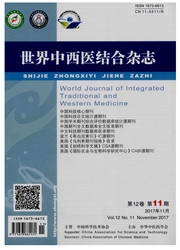

 中文摘要:
中文摘要:
目的观察痛风泰颗粒对尿酸钠(MSU)诱导的兔膝滑膜组织中白细胞介素-1β(IL-1β)和肿瘤坏死因子-α(TNF-α)表达的影响。方法取3只实验兔分别空腹灌胃生理盐水、痛风泰颗粒溶液、戴芬溶液,1 h后抽取静脉血,离心取血清编号为血清1、血清2、血清3,采用改良组织块培养法培养第4代滑膜细胞,随机分为空白组(NS+血清1)、模型组(MSU+血清1)、中药组(MSU+血清2)、西药组(MSU+血清3)培养3 d后,应用ELISA法测定每组滑膜细胞培养液中IL-1β和TNF-α含量;用细胞蛋白定量法检测各组培养孔细胞蛋白定量。结果模型组IL-1β、TNF-α的水平明显高于中药组、西药组及空白组,差异有统计学意义(P〈0.05);中药组和西药组之间的IL-1β、TNF-α水平比较,差异无统计学意义(P〉0.05)。各组间细胞蛋白定量比较,差异无统计学意义(P〉0.05)。结论痛风泰颗粒能够显著抑制尿酸钠诱导的兔滑膜组织IL-1β和TNF-α的表达,表明痛风泰颗粒对痛风的治疗作用可能是通过抑制滑膜组织炎症因子IL-1β和TNF-α的释放实现的。
 英文摘要:
英文摘要:
Objective To observe the impacts of tongfengtai granules on the expressions of IL-1β and TNF-α in synoviocytes of rabbit induced by monosodium urate(MSU).Methods Fasting gastric lavage of physical saline,tongfengtai granule solution and diclofenac sodium dual solution were administered in 3 experimental rabbits separately.1h later,venous blood sample was collected and serum was centrifuged and coded as serum No.1,No.2 and No.3.The modified tissue explant technique was adopted for culturing synoviocytes of the 4th generation,which was randomized into blank group(NS+serum No.1),model group(MSU+serum No.1),Chinese medicine group(MSU+serum No.2)and western medicine group(MSU+serum No.3).After cultured for 3 days,ELISA method was applied to determine the contents of IL-1β and TNF-α in synoviocyte medium of each group.Cellular proteins quantitative method was used to detect the amount of cellular proteins in cultivating hole.Results The levels of IL-1β and TNF-α in model group were higher apparently than those in Chinese medicine group,western medicine group and blank group,presenting statistical significant difference(P0.05).There was no statistical difference in the levels of IL-1β and TNF-α in comparison between Chinese medicine group and western medicine group(P0.05).There was no statistical difference in cellular proteins quantitative measurement among groups(P0.05).Conclusion Tongfengtai granules inhibit significantly the expressions of IL-1β and TNF-α in synoviocytes of rabbit induced by MSU,indicating that tongfengtai granules are effective on gout through its inhibition on the release of synovial tissue inflammatory factors,IL-1β and TNF-α.
 同期刊论文项目
同期刊论文项目
 同项目期刊论文
同项目期刊论文
 期刊信息
期刊信息
